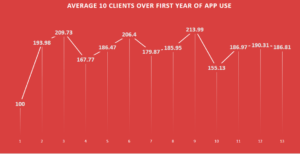Glasgow Caledonian University Study on Sales Data
SalesFitness Group believe that there are three levers that can be pulled to improve sales performance.
Activity – the right quantity of sales contacts
Concentration of effort – talking to the right people in the right organisations about the right things
Effectiveness- selling in the right way.
SalesWisdom, the thought leadership and analytics division of SalesFitnessGroup commissioned an independent research project conducted in 2020. The study looked at how the levels of sales activity could be improved and what happened when a sales team re-examined its concentration of effort.
This research project conducted in 2020, looked at how the levels of activity can be improved and what happened when a sales team re-examined its concentration of effort.
The project was undertaken as part of a dissertation for an M.Sc.in Big Data by Aliona Tarasenco under the supervision of Dr. Yan Zhang and Professor Gordon Morrison of the Department of Computing, Glasgow Caledonian University. The M.Sc. was awarded a Distinction.
Activity levels
The first lever that was analysed was activity. The research anonymously and randomly measured the number of customer visits before and after using SalesRelay taking 107,302 customer visits by salespeople from 10 sales teams selected randomly from the client base.
The baseline was 100 and the change in the number of calls was measured over 4 week periods for a year. Simply concentrating on activity levels, recording them via the app and reporting to management had an immediate effect which was maintained through the year. There was also a significant impact because recording on the app saved wasted time recording and reporting.

There were a couple of seasonal dips but even 12 months in, the app usage was resulting in 87% more calls being made than at the start of usage.
While the variable costs of selling increased (e.g. miles travelled) the fixed costs (e.g. sales salaries) remained unchanged. So a salesperson with £50,000 fixed costs carrying out 10 sales visits a week a the start of the usage had a fixed cost per call of £96 whereas a year later their cost per call had dropped to £51 (fixed costs excluding extra mileage etc.)
The data did not allow for a direct correlation between number of calls and sales result there was no evidence of a change in conversion ratios.
It is clear that one of the simplest and quickest ways of improving the sales result is to raise activity levels. This could be by increasing the size of the salesforce or by increasing the call-rate of existing salespeople. This can be achieved by more active management, setting intelligent but clear activity targets and by removing “time stealers” such as admin tasks.
Concentration of effort
One company in the study saw how concentration of effort impacts on conversion ratios. The analysis of the data in this part of the research 121.465 visits were analysed to observe the impact of talking to different people about different products.
The research showed sales visits to buyers with the job title “director” achieved a conversion ratio of 56% compared to a 27% rate for those with the title “manager”. And with higher value sales, the gap widened further to 35% for directors compared to only 10% for managers.
The research also showed that picking the right product to sell was essential. One company in the study didn’t take advantage of the data they had available to understand the difference in conversion ratios. The analysis of the data showed that where salespeople concentrated on product A, they achieved a conversion ratio of only 7% but managed a 59% conversion ratio for product B. It means that it took 2 visits to sell product B but 14 visits to sell product A.
Effectiveness
There are many aspects of sales effectiveness from individual skills to management coaching. The research focussed on one element only – the way sales people planned their sales visits and could explain the purpose of a call i.e. they defined why they were conducting the visit. Where salespeople are asked to record the call’s purpose. The research looked at the difference between a “territory call”, where the salesperson dropped in to see the customer without an agenda, and a planned call with a defined purpose and pre-agreed agenda. Unplanned calls generated a 23% conversion. However, where a definite goal was agreed, the conversion ratio improved to 68%.
Conclusions
Pulling the right levers can have a measurable impact on the result.
Increasing activity levels is probably the fastest way to have an impact.
Changing the concentration of effort can have a significant effect on conversion ratios and average value.
Improving individual and team effectiveness carries across to improved conversion ratios and (not covered in this piece of research) margins, share of wallet and order value.
Interestingly the data was a much better analyser of a “good” sales call than the opinion of the individual salesperson. Salespeople were asked their view of whether the sales call had gone well, badly or ‘no comment’. The calls perceived by the salesperson as positive saw a conversion ratio of 27% while those that were not perceived as positive achieved a 20% conversion. There is not much correlation between a call perceived as positive and one perceived as neutral or negative. Opinion will give you some indication, but when you compare what opinion tells you and what data tells you, then data-based decision making clearly is more effective. The conclusion is clear; if you don’t have this level of data, then you’re putting money into your salesforce to operate in the dark
Every aspect of the sales operation can be measured and quantified to drive insight that can transform the effectiveness of sales teams and accelerate the growth of the business.
SalesWisdom, the thought leadership and analytics division of SalesFitnessGroup recognises the importance of independent research and working with Universities to further our mission of supporting professional sales and the integrity of our insights and results – expect more in future newsletters.
